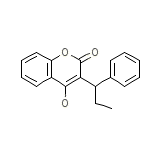Phenprocoumarol




Categoria
Phenprocoumarol Marchi, Phenprocoumarol Analoghi
Phenprocoumarol Marchi miscela
Phenprocoumarol Formula chimica
C18H16O3
Phenprocoumarol RX link
No information avaliable
Phenprocoumarol FDA foglio
Phenprocoumarol DMS (foglio di materiale di sicurezza)
Phenprocoumarol Sintesi di riferimento
Nessuna informazione disponibile
Phenprocoumarol Peso molecolare
280.318 g/mol
Phenprocoumarol Temperatura di fusione
179.5 oC
Phenprocoumarol H2O Solubilita
12,9 mg / L
Phenprocoumarol Stato
Solid
Phenprocoumarol LogP
4.59
Phenprocoumarol Forme di dosaggio
Compressa
Phenprocoumarol Indicazione
Utilizzato per la prevenzione e il trattamento delle malattie tromboemboliche tra cui trombosi venose, tromboembolia, ed embolia polmonare, nonché per la prevenzione di ictus ischemico nei pazienti con fibrillazione atriale (FA).
Phenprocoumarol Farmacologia
Fenprocumone, un anticoagulante cumarina, fluidifica il sangue di vitamina K antagonista che è richiesta per la produzione di fattori della coagulazione nel fegato. Anticoagulanti come fenprocumone hanno alcun diretto effetto su un trombo stabilito, né contrario danno ischemico tissutale (danno causato da un inadeguato apporto di sangue a un organo o parte del corpo). Tuttavia, una volta che un trombo si è verificato, l'obiettivo della terapia anticoagulante è quello di prevenire ulteriore estensione del coagulo formato e prevenire le complicanze tromboemboliche secondario che può provocare conseguenze gravi e anche mortali.
Phenprocoumarol Assorbimento
La biodisponibilità è vicina al 100%
Phenprocoumarol Tossicita
50 = 500 mg / kg. Sintomi di sovradosaggio comprende sospetta o conclamata sanguinamento anomalo (per esempio, la comparsa di sangue nelle feci o urine, ematuria, sanguinamento mestruale eccessivo, melena, petecchie, ecchimosi eccessiva o persistente stillicidio da lesioni superficiali).
Phenprocoumarol Informazioni paziente
The objective of anticoagulant therapy is to decrease the clotting ability of the blood so that thrombosis is prevented, while avoiding spontaneous bleeding. Effective therapeutic levels with minimal complications are in part dependent upon cooperative and well-instructed patients who communicate effectively with their physician. Patients should be advised: Strict adherence to prescribed dosage schedule is necessary. Do not take or discontinue any other medication, including salicylates (e.g., aspirin and topical analgesics), other over-the-counter medications, and botanical (herbal) products (e.g., bromelains, coenzyme Q10, danshen, dong quai, garlic, Ginkgo biloba, ginseng, and St. John's wort) except on advice of the physician. Avoid alcohol consumption. Do not take phenprocoumon during pregnancy and do not become pregnant while taking it. Avoid any activity or sport that may result in traumatic injury. Prothrombin time tests and regular visits to physician or clinic are needed to monitor therapy. Carry identification stating that phenprocoumon is being taken. If the prescribed dose of phenprocoumon is forgotten, notify the physician immediately. Take the dose as soon as possible on the same day but do not take a double dose of phenprocoumon the next day to make up for missed doses. The amount of vitamin K in food may affect therapy with phenprocoumon. Eat a normal, balanced diet maintaining a consistent amount of vitamin K. Avoid drastic changes in dietary habits, such as eating large amounts of green leafy vegetables. Contact physician to report any illness, such as diarrhea, infection or fever. Notify physician immediately if any unusual bleeding or symptoms occur. Signs and symptoms of bleeding include: pain, swelling or discomfort, prolonged bleeding from cuts, increased menstrual flow or vaginal bleeding, nosebleeds, bleeding of gums from brushing, unusual bleeding or bruising, red or dark brown urine, red or tar black stools, headache, dizziness, or weakness. If therapy with phenprocoumon is discontinued, patients should be cautioned that the anticoagulant effects of phenprocoumon may persist for about 2 to 5 days.
Phenprocoumarol Atto interessato organismi
Gli esseri umani e altri mammiferi














